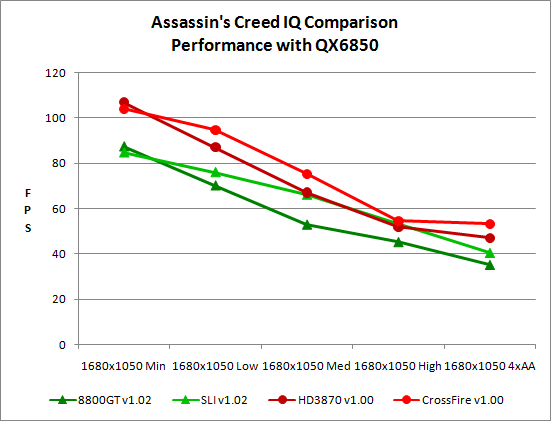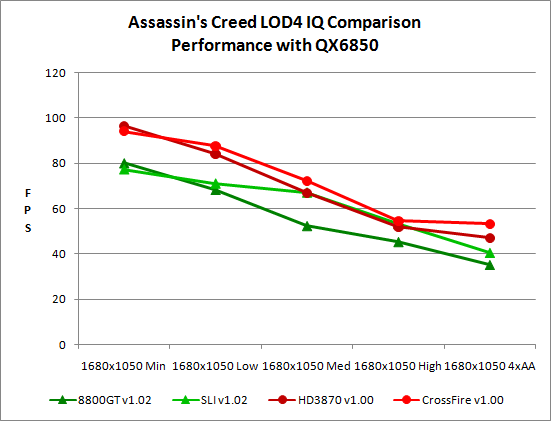Image Quality Settings and Performance
While we're inclined to say that AC only requires a "midrange" graphics card these days -- both the 8800 GT and HD 3870 can be purchased for under $200 -- there are still plenty of people out there that don't have sufficiently fast hardware to run this game at maximum settings. Lacking appropriate hardware to test a variety of other graphics cards, I instead opted to look at how the graphics settings affect performance and image quality. Below you will find image galleries showing the various settings tested as well as how those settings affect the image quality.
Subjectively, we can state of few things. First, at the lowest detail setting AC looks pretty awful. This is not a knock against the game, but it's important to remember that on low-end hardware it's essentially impossible to perform all of the high-end graphics effects. Without basic shadows and lighting, AC looks like something that would have been state-of-the-art about six or seven years ago. (The same could be said of most modern games.)
Bumping up the graphics detail to "low" enables basic (static) lighting effects, and AC looks substantially better. We still wouldn't recommend playing this way if you can avoid it, but at least it's no longer an eyesore. Note also that you can enable a high level of detail with only a moderate performance hit, which would improve the overall image quality slightly. (See below for more details.)
At our "medium" settings, the game finally starts to look like a modern title. It's likely that owners of graphics cards like the GeForce 8600 series and HD 2600 series will be best off running at medium settings, and they should be able to achieve reasonable performance at 1280x1024 (1280x720 with black bars on the top and bottom).
Finally, at maximum detail the shadow range is extended, texture quality is improved, and you get a very attractive rendition of 12th century humanity. Performance drops by roughly 20% compared to "medium" settings, and as already discussed enabling anti-aliasing will further reduce performance.
At all graphics detail settings above one, you can also choose to enable or disable "Post FX". The major area this affects is the presence or lack of motion blur when you're moving at a high rate of speed -- i.e. diving from a high point into a pile of hay or galloping on a horse. Disabling this did not appear to have a major impact on performance.

While reducing detail settings will improve performance to a certain degree, it's also important to note that CPU and overall system performance remain factors. We did some initial benchmarking with our quad-core QX6850 (really an overclocked Q6600) to see what sort of performance we were looking at. That's no slouch of a processor, and yet maximum performance even at minimum detail settings appears to top out at just over 100 FPS. Obviously, lower-end systems would not perform as well, so make sure you have sufficient CPU horsepower. The CPU-limited nature of the game is also apparent by looking at the single versus dual-GPU scores; with a 3.0GHz Core 2 processor at 1680x1050, the largest performance improvement from a second GPU is only 25%: SLI at "Medium" settings; CrossFire tops out at only a 13% performance boost.

When we perform the same test as above but leave the LOD at four (the maximum setting), it's no surprise that performance drops as we become more CPU bound. (Level of Detail influences the draw distance and amount of detail seen on distant object, among other things.) Other than that, there's little difference in performance scaling. Due to the CPU-limited nature, we again see lower settings running faster with a single GPU than SLI/CrossFire.
















32 Comments
View All Comments
geogaddi - Tuesday, June 10, 2008 - link
...now, what did i do with that babelfish...
ssgoten00 - Monday, June 2, 2008 - link
AC was only an average game overall. Graphics presentation was it's strong suit but gameplay was lacking and the game seemed to drag on as the player progresses through the game. Undoubtedly the repetitiveness was the worst part of AC. Not simply the fact that is seemed like some tasks were a redue of previously accomplished tasks but the shear fact that tasks were repeated verbatim with same characters and voices, only changing dialogue to create variation. Some characters players will have to kill multiple times under the guise of actually killing different characters in the game. AC was also disappointing in the fact that it mislead gamers in presenting its self a a somewhat stealth game. Nothing could be further from the truth. In AC players will often be forced into full on combat with multiple opponents to progress in the storyline. In vary select situations players have the choice of using stealth as a viable option. Ironically the last 5 or 10 minutes at the very end of the game are the most compelling. After the credits roll players are left in the main room to explore and decrypt code and hidden messages. It's unfortunate AC's developers couldn't have spent more time on puzzles that actually pertained to gameplay. Out of a possible 10 I give Assassin's Creed a 6.0 barely coming in at par, bordering on subpar.Donkey2008 - Monday, June 2, 2008 - link
It does have a Thief feel but after playing it on Xbox, I found it to be more Thief meets BloodRayne meets Splinter Cell with some of the best graphics I have seen in a while. It is sorta repetitive,but the violence cut away any boredom I had. I enjoyed it a lot.But I guess they could have done what other Rockin high-profile companies do and make an even more repetitive game exactly like its previous versions, but with a much worse soundtrack. Throw in some terribly low-res character models and reuse the same, bottom-of-the-barrel, cartoon-looking cutscenes and they would have a perfect 10 as well.
poohbear - Monday, June 2, 2008 - link
this is the kind of game reviews i'd like to see, wherein hardware is tested w/ a game to show performance. I mean, you guys ARE a hardware site and there are'nt many sites that do game reviews w/ hardware testing shortly after. I dont think u should do game reviews without hardware testing cause there are a ton of game review sites, but your niche shines when you do these hardware and DX analysis. cheers and thanks for a very informative article.DesertCat - Monday, June 2, 2008 - link
The article talks about wanting to check the performance of Assassin's Creed on a Phenom processor (and its 4 cores). I can speak to that to some degree.I have a Phenom 9600 (2.3 MHz) on an AM2 board (Asus M2N-SLI Deluxe) with an EVGA 8800GT OC (650 MHz). I play at 1280x1024 so I play in a letterbox mode. This processor is enough to run the game at acceptable frame rates but I would tend to think that a fast dual core would do just as well (like was found with the Intel processors in the article).
With the performance hurting TLB patch enabled, I noticed one area where frame rates truly took a nosedive: when doing the "look" pan from the top of one of those towers. I didn't have an fps counter on at the time, but I'm guessing it was in the 12-16 fps range based on the chunkiness I experienced. I got similar slow framerates when diving from those spots into the hay (especially the really high towers).
With the TLB patch disabled on my Phenom, those two low fps spots were much better. I'm guessing that those areas were in the low 20's of fps. The rest of the game was smooth as silk and probably above 40 fps. I do not, however, see high utilization on any particular core when I've checked.
If I was to point to areas that really stress a system in AC, I would say that the tower pan shots are the most common. (*minor spoiler ahead*) King Richard's speech from horseback about 3/4 the way through the game is also very intensive.
aguilpa1 - Monday, June 2, 2008 - link
I know I've had it for a long time?emboss - Monday, June 2, 2008 - link
The word you *are* looking for is possibly letterboxing?PrinceGaz - Monday, June 2, 2008 - link
I was going to mention that as well. Anamorphic means the pixels making up the image are stretched either horizontally (as with wide-screen DVDs) or vertically when displayed. If the game were anamorphic, it would be like it running on a monitor at 1920x1080 but being rendered internally at some other resolution such as 1440x1080 and stretched to the displayed 1920x1080.The correct description is what you said originally, that it allows only a 16:9 aspect-ratio view, so if I ran it on my monitor (1600x1200 native) the game itself would only use the central 1600x900 of that.
JarredWalton - Tuesday, June 3, 2008 - link
Sorry - I saw the original comment and thought I corrected it. Missed the other two occurrences. I wasn't thinking and just used the word after reading the thread on widescreengamingforum.com about AC. (I was hoping someone had found a way around the locked letterbox view.)AnnihilatorX - Monday, June 2, 2008 - link
This review is great! I have never read a game review that includes all the analysis, benchmarks, gameplay video conveniently presented.Excellent work!